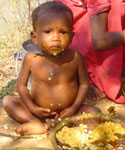Thirty-eight percent of children in urban India are underweight as poor sanitation aggravates the food shortages faced by the poor, a UN report said.
With more than one billion people, India has the most hungry people in the world, said the study by the World Food Programme (WFP).
The report found that 38 percent of children were below their normal weight and 36 percent were shorter than they should be, with the problems most acute in Madhya Pradesh and Bihar.
While many malnourished Indians live in Mumbai and New Delhi, hunger is even more serious in the smaller cities, where access to jobs and basic resources is often most scarce, the study said.
“The poor who migrate from rural to urban areas seeking better livelihoods are illiterate and unskilled; the vast majority of them are unable to enter the organised industrial sector and consequently coalesce into a bloated informal sector or poorly paid day laborers trapped in an uncertain and precarious existence,” it said.
The study said poor sanitation was a “direct contributing factor” to hunger. “Open-air defecation and sewage waste, contaminated drinking water and widespread garbage provide a fertile breeding ground for mosquitoes and flies, especially during the seasonal floods,” it said.
“The resultant diseases are difficult to fight for people already weakened by lack of food.”
India’s woes can provide lessons to the rest of the world, where urbanization is increasing at an alarming pace. In India, 600 million people will live in urban areas by 2025, the study said.
“Urbanization is perhaps the most dominant demographic phenomenon of recent decades worldwide,” said Mohamed Zejjari, the special representative in India for WFP Executive Director James Morris.
The WFP report, entitled the Food Insecurity Atlas of Urban India, called on authorities to focus on ensuring clean drinking water and proper garbage disposal.
It also said efforts should concentrate on children through programs to promote school attendance and feed schoolchildren.

